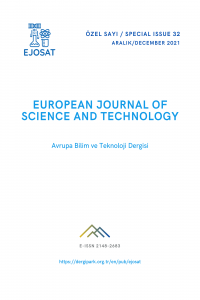Abstract
Omurlararası diskler, omurgaya gelen darbelere karşı koymak için bir amortisör görevi görür. Bu elemanlar, basınç uygulandığında deforme olma yeteneğine sahiptir, böylece darbelerin yoğunluğunu azaltır. Disklerin ana şekli, basınç altında olmadığında küreseldir; ancak omurların arasına yerleştirildiklerinde basınç altında genişlerler. Omurlararası disklerin önemli işlevlerinden biri, omurgadaki hareketleri kolaylaştırmaktır.
Biyolojik mekaniği mühendislik altyapılarından biri olarak incelemek için, bu yazıda, doymuş gözenekli yumuşak doku olarak intervertebral disklerin birleşik modellemesi tartışılmaktadır. İlk olarak sürekli ortam mekaniğine göre matematiksel model çıkarılmış ve daha sonra ANSYS program paketi ile sonlu elemanlar modeli hazırlanmıştır. Mevcut tıbbi bilgilere göre farklı yüklere dayanarak diskin biyomekanik davranışı araştırıldı. Bu model, hastalarda ameliyattan önce veya sonra intervertebral disklerin davranışını araştırmak için kullanılabilir.
Bu yazıda, matematiksel modele ek olarak, diskin mekanik davranışı ve farklı yükler altındaki gerilme dağılımı incelenmiştir.
References
- Suh, J. K., & DiSilvestro, M. R. (1999). Biphasic poroviscoelastic behavior of hydrated biological soft tissue. Journal of Applied Mechanics, 66(2), 528-535.
- Yang, Z., & Smolinski, P. (2006). Dynamic finite element modeling of poroviscoelastic soft tissue. Computer Methods in Biomechanics and Biomedical Engineering, 9(1), 7-16.
- Lai, W. M., Hou, J. S., & Mow, V. C. (1991). A triphasic theory for the swelling and deformation behaviors of articular cartilage.
- Nikkhoo, M., Haghpanahi, M., Peirovi, H. A. B. I. B. A. L. L. A. H., & Ghanavi, J. E. (2007). Mathematical model for tissue engineered intervertebral disc as a saturated porous media. In Proceedings of the 3rd International Conference on Applied and Theoretical Mechanics (pp. 197-201).
- Sun, D. N., Gu, W. Y., Guo, X. E., Lai, W. M., & Mow, V. C. (1999). A mixed finite element formulation of triphasic mechano‐electrochemical theory for charged, hydrated biological soft tissues. International Journal for Numerical Methods in Engineering, 45(10), 1375-1402.
- Gaudenzi, P., & Bathe, K. J. (1995). An iterative finite element procedure for the analysis of piezoelectric continua. Journal of Intelligent Material Systems and Structures, 6(2), 266-273.
- Houben, G. B., Drost, M. R., Huyghe, J. M., Janssen, J. D., & Huson, A. (1997). Nonhomogeneous permeability of canine anulus fibrosus. Spine, 22(1), 7-16. Urban, J. P. G., & Maroudas, A. (1981). Swelling of the intervertebral disc in vitro. Connective tissue research, 9(1), 1-10.
- Ferguson, S. J., & Steffen, T. (2005). Biomechanics of the aging spine. The aging spine, 15-21.
- Stadelmann, M. A., Stocker, R., Maquer, G., Hoppe, S., Vermathen, P., Alkalay, R. N., & Zysset, P. K. (2020). Finite element models can reproduce the effect of nucleotomy on the multi-axial compliance of human intervertebral discs. Computer methods in biomechanics and biomedical engineering, 23(13), 934-944.
Analysis of the Biomechanical Behavior of the Intervertebral Discs by Modeling Three-Phase Finite Elements
Abstract
Intervertebral discs act as a shock absorber to counteract the blows to the spine. These elements have the ability to deform when applied pressure, thus reducing the intensity of impacts. The main shape of discs is spherical when not under pressure; but when they are placed between the vertebrae, they expand under the pressure. One of the important functions of intervertebral discs is to facilitate movements in the spine
In order to study biological mechanics as one of the engineering infrastructures, in this paper, the combined modeling of finite element intervertebral discs as a saturated porous soft tissue is discussed. First, according to the continuum mechanics, the mathematical model is extracted and then the finite element model is prepared by ANSYS program package. Based on the different loads according to the available medical information, the biomechanical behavior of the disk was investigated. This model can be used to investigate the behavior of intervertebral discs in patients before or after surgery.
In this paper, in addition to the mathematical model, the mechanical behavior of the disk and the stress distribution under different loads were investigated.
References
- Suh, J. K., & DiSilvestro, M. R. (1999). Biphasic poroviscoelastic behavior of hydrated biological soft tissue. Journal of Applied Mechanics, 66(2), 528-535.
- Yang, Z., & Smolinski, P. (2006). Dynamic finite element modeling of poroviscoelastic soft tissue. Computer Methods in Biomechanics and Biomedical Engineering, 9(1), 7-16.
- Lai, W. M., Hou, J. S., & Mow, V. C. (1991). A triphasic theory for the swelling and deformation behaviors of articular cartilage.
- Nikkhoo, M., Haghpanahi, M., Peirovi, H. A. B. I. B. A. L. L. A. H., & Ghanavi, J. E. (2007). Mathematical model for tissue engineered intervertebral disc as a saturated porous media. In Proceedings of the 3rd International Conference on Applied and Theoretical Mechanics (pp. 197-201).
- Sun, D. N., Gu, W. Y., Guo, X. E., Lai, W. M., & Mow, V. C. (1999). A mixed finite element formulation of triphasic mechano‐electrochemical theory for charged, hydrated biological soft tissues. International Journal for Numerical Methods in Engineering, 45(10), 1375-1402.
- Gaudenzi, P., & Bathe, K. J. (1995). An iterative finite element procedure for the analysis of piezoelectric continua. Journal of Intelligent Material Systems and Structures, 6(2), 266-273.
- Houben, G. B., Drost, M. R., Huyghe, J. M., Janssen, J. D., & Huson, A. (1997). Nonhomogeneous permeability of canine anulus fibrosus. Spine, 22(1), 7-16. Urban, J. P. G., & Maroudas, A. (1981). Swelling of the intervertebral disc in vitro. Connective tissue research, 9(1), 1-10.
- Ferguson, S. J., & Steffen, T. (2005). Biomechanics of the aging spine. The aging spine, 15-21.
- Stadelmann, M. A., Stocker, R., Maquer, G., Hoppe, S., Vermathen, P., Alkalay, R. N., & Zysset, P. K. (2020). Finite element models can reproduce the effect of nucleotomy on the multi-axial compliance of human intervertebral discs. Computer methods in biomechanics and biomedical engineering, 23(13), 934-944.
Details
| Primary Language | English |
|---|---|
| Subjects | Engineering |
| Journal Section | Articles |
| Authors | |
| Publication Date | December 31, 2021 |
| Published in Issue | Year 2021 Issue: 32 |


